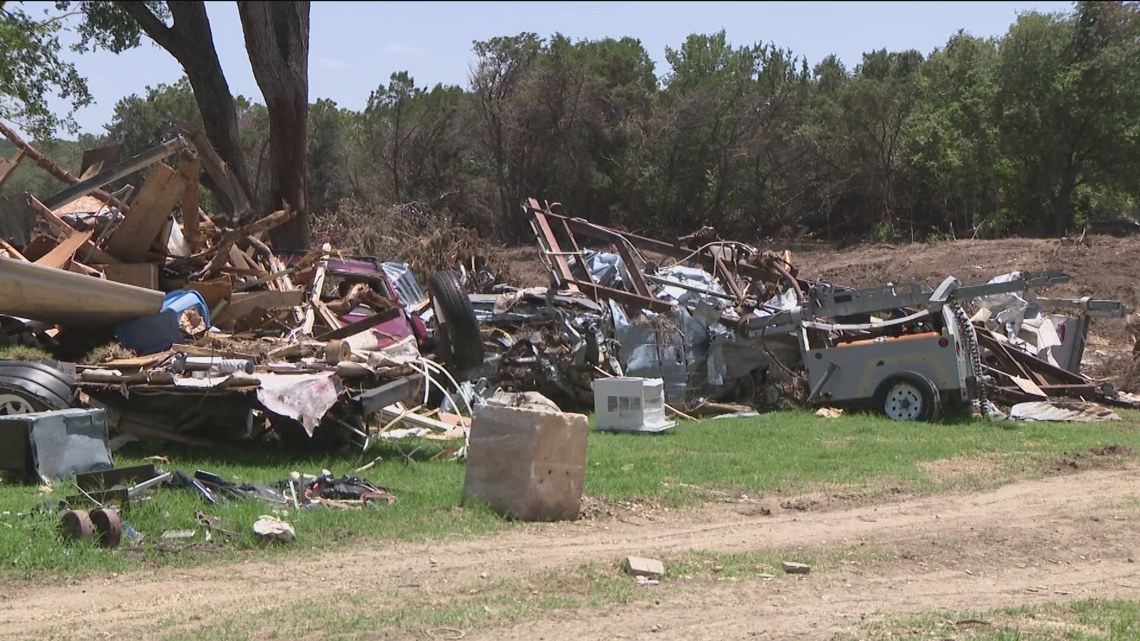
Many victims of the recent flooding did not have flood insurance when water washed away homes, cars and belongings.
LEANDER, Texas — Across Central Texas, recovery is continuing in communities devastated by floods, but it will be a long and expensive road ahead.
In the Big Sandy Creek area, crews are documenting and accounting for what is damaged or destroyed as part of the process that counties must go through to meet the threshold for qualifying for additional federal assistance.
Burnet, Williamson and Travis Counties have all qualified for the FEMA individual assistance program.
So far, only Burnet has been approved for federal public assistance, which helps local governments with emergency costs, debris and repairs. Gov. Greg Abbott has requested the White House add Williamson County, but not yet Travis.
During a press conference on Monday, Texas Department of Emergency Management Chief Nim Kidd said he is confident that Travis County will meet the threshold and that the state is working with the county to get the documentation to FEMA.
It takes time to confirm this in a larger county like Travis, as the threshold for public assistance is a mathematical equation based on the extent of damage compared to the overall population.
“The less-populated counties have a much smaller threshold of $500 to $600,000 versus millions of dollars for this population,” Kidd said.
Insurance process
If you have damage from the recent floods, document the damage and file your insurance claims promptly.
Many victims of the recent flooding did not have flood insurance when the water washed away their homes, cars and belongings.
Mistie Hinote with the Texas Department of Insurance said flood insurance is not usually covered in a standard homeowner’s policy.
“Most people buy that either as a separate policy through their insurance company, or they buy that through the National Flood Insurance Program,” Hinote said. “A lot of people are realizing maybe they had a homeowner’s insurance policy they thought covered everything and are realizing they don’t have flood coverage.”
If you don’t have flood insurance, Hinote said FEMA can help you with repairs.
“If you live in one of the counties that’s been declared a presidential disaster area, you can call FEMA and apply for assistance,” Hinote said. “FEMA helps with repairs that insurance doesn’t cover. If you just don’t have insurance or you don’t have enough insurance, you can apply with FEMA for help.”
You do need to obtain a denial letter from your homeowner’s insurance company, essentially stating that you don’t have insurance.
“If you don’t have insurance, they’re going to recommend that you get a denial letter from your homeowner’s insurance company saying, ‘I don’t have insurance,’ and FEMA is going to use that when you apply to decide how much they’re going to give you in grants,” Hinote said.
Disaster Recovery Center
Williamson County is opening a Disaster Recovery Center on Friday to provide in-person support for residents affected by the July flood. It will be open through Aug. 10 at the Williamson County EMS North Campus, located at 3189 SE Inner Loop in Georgetown. No appointment is necessary.
FEMA representatives will be on-site to assist residents who have suffered flood-related damage or losses not covered by insurance. They will assist with navigating disaster assistance programs, answering questions and providing support. The county said FEMA can help with temporary housing, home repairs, personal property losses and other disaster-related needs such as medical and dental expenses.
‘I would like to get on with my life’
Harold Sherwood’s house along Windy Valley Road is totaled after he said the water got up to 6 feet high on the walls. It is surrounded by piles of debris filled with trees, rubble, sheet metal, trailers and whatever else the water brought with it. It left a car leaning up against the house.
Sherwood said the only thing that kept it from floating away was the steel beams.
“My house is destroyed. There’s nothing left,” Sherwood said. “It all floated out.”
Sherwood has lived in the house since 2003 and said he did have flood insurance.
He said the adjuster has been out to survey the damage.
“He took pictures, took measurements, that sort of thing,” Sherwood said. “It’s just a matter of the company saying, ‘OK, we’ll settle for that,’ and I’ll say yes or no.”
Sherwood said he has to wait 30 days for the insurance company to make a decision. For homeowners like him, it is a frustrating wait.
“I wish I could settle up and I can get on with my life,” he said. “I don’t know how much more I have in life, but I would like to get on with my life.”
He said if the insurance company doesn’t knock the house down, he will. He said he had outside coverage of around $70,000, coverage of $6,000 to $7,000 for inside property and $3,000 for his shop.
“Hopefully, I’ll get something out of it,” Sherwood said.
More assistance
If you have insurance questions, you can call the Texas Department of Insurance Help Line at 800-252-3439 from 8 a.m. to 5 p.m. Monday through Friday.
As emergency officials continue to assess the damage from flooding across Central Texas, the Texas Department of Emergency Management is seeking the public’s assistance. TDEM is asking anyone with property damage to report it using the Individual State of Texas Assessment Tool, or ISAT. It’s a survey that helps TDEM record and track all the damage across the region.
Doing this helps authorities connect people with resources and services, making it easier to determine whether counties meet the thresholds for federal disaster assistance.
The survey will ask you questions about the damage and what your current needs are. It will also ask you to take multiple photos of the damage.
If you don’t have internet, you can report damage over the phone by calling 1-800-621-3362.
